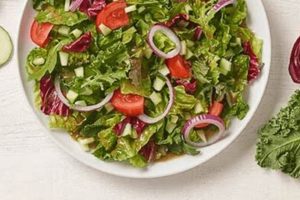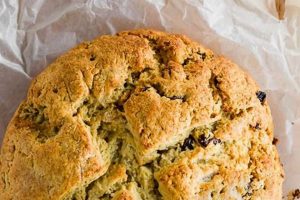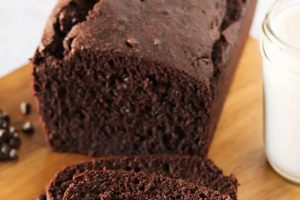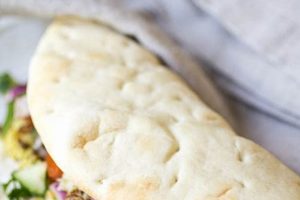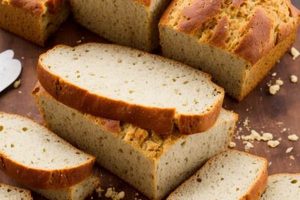A plant-based and grain-alternative baked good, this item offers a moist and flavorful treat suitable for individuals with dietary restrictions. It commonly involves replacing standard ingredients like eggs, dairy, and wheat flour with plant-derived alternatives and gluten-free flours to create a satisfying bread. For instance, applesauce can substitute eggs, while almond flour and tapioca starch can replace wheat flour, resulting in a baked loaf incorporating shredded summer squash.
This specific creation addresses a growing need for inclusive food options. It allows those avoiding animal products and gluten to enjoy a classic baked comfort food. Its development represents an evolution in baking techniques, responding to increased awareness of dietary sensitivities and ethical food choices. The incorporation of vegetables provides added nutritional value, making it a potentially healthier alternative to conventional baked goods.
The subsequent sections will delve into the specifics of its preparation, ingredient selection, potential variations, and relevant considerations for achieving optimal results. Detailed recipes and baking tips will be included to aid successful creation of this delicious dietary-conscious product.
Essential Guidance for Successful Baking
Achieving optimal results with this specialized loaf requires careful attention to specific techniques and ingredient considerations. The following guidance addresses common challenges and promotes a favorable outcome.
Tip 1: Flour Blend Optimization: Gluten-free flour blends vary in composition and behavior. Experimentation with different combinations of rice flour, tapioca starch, and almond flour is advisable to achieve the desired texture. A 1:1 gluten-free all-purpose blend can serve as a starting point, but adjustments may be necessary.
Tip 2: Moisture Management: Zucchini’s high water content requires precise management. Shredded zucchini should be gently squeezed to remove excess moisture before incorporating it into the batter. This prevents a soggy final product and promotes even baking.
Tip 3: Binding Agent Selection: Vegan baking often requires replacing eggs, which provide binding and structure. Flaxseed meal mixed with water creates a suitable binding agent. Allow the mixture to sit for five minutes to thicken before adding it to the batter.
Tip 4: Sweetener Choice: The type of sweetener impacts the final texture and flavor. Liquid sweeteners like maple syrup or agave nectar add moisture, while granulated sugars provide structure. Consider the overall flavor profile when selecting a sweetener.
Tip 5: Spice Enhancement: Spices complement the zucchini’s subtle flavor. Cinnamon, nutmeg, and ginger are commonly used. Adjust the amounts to suit individual preferences.
Tip 6: Baking Time Vigilance: Baking times may vary depending on oven calibration and pan material. Regularly check the loaf’s internal temperature with a toothpick or skewer. It is done when the toothpick comes out clean or with a few moist crumbs.
Tip 7: Cooling Procedure: Allow the baked loaf to cool in the pan for at least ten minutes before transferring it to a wire rack to cool completely. This prevents the loaf from crumbling and allows the flavors to meld.
Implementing these strategies will enhance the likelihood of producing a delicious and structurally sound baked creation.
The subsequent segment will address recipe variations and creative additions to further personalize the baking experience.
1. Texture
Texture in vegan gluten-free zucchini bread is a critical attribute, significantly impacting the overall eating experience. Achieving a desirable texture presents unique challenges due to the absence of gluten and traditional binding agents like eggs. The interaction between alternative flours, moisture content, and binding agents directly determines whether the final product is tender, crumbly, dense, or unpleasantly gummy. For instance, an overabundance of tapioca starch can result in an excessively chewy texture, while insufficient moisture leads to a dry and crumbly loaf. Understanding the relationship between these factors is paramount to crafting a palatable product.
The selection and proportion of gluten-free flours play a crucial role. A blend of rice flour, almond flour, and tapioca starch, carefully balanced, can mimic the structure and chewiness that gluten provides. Too much rice flour might create a gritty texture, while excessive almond flour can lead to a dense, heavy loaf. The amount of zucchini added influences the moisture content. Overly moist zucchini, not adequately drained, can lead to a gummy, undercooked center. Therefore, precise moisture management is essential. Practical applications include squeezing excess liquid from shredded zucchini and adjusting the liquid ingredients based on zucchini moisture levels. The use of psyllium husk can also improve the final texture by acting as a binding agent.
In summary, mastering texture is fundamental to producing an appealing vegan gluten-free zucchini bread. The absence of gluten necessitates strategic choices in flour blends, moisture regulation, and binding agent selection. Attention to these details, and iterative refinement based on baking outcomes, allows for the creation of a baked item that meets the textural expectations of consumers, thereby contributing to its overall appeal and success. Overcoming textural challenges requires a deep understanding of ingredient properties and their impact on the final product.
2. Moisture
Moisture plays a pivotal role in the quality and structural integrity of vegan gluten-free zucchini bread. The water content, originating primarily from the zucchini itself, significantly influences the bread’s texture, density, and overall palatability. Careful management of this moisture is crucial to prevent undesirable outcomes such as a soggy interior or a dry, crumbly consistency.
- Zucchini’s Contribution
Zucchini, as the namesake ingredient, introduces a substantial amount of moisture to the batter. The water content varies based on the zucchini’s size, maturity, and variety. Failure to account for this inherent moisture can lead to an excessively wet batter, resulting in a dense and undercooked bread. Conversely, using too little zucchini may lead to dryness. A common practice involves grating the zucchini and subsequently squeezing out excess liquid before incorporation to mitigate these effects. This step is crucial for achieving a balanced moisture level.
- Flour Absorption Capacity
Gluten-free flours exhibit varying degrees of water absorption compared to traditional wheat flour. Some, like rice flour, tend to absorb less moisture, while others, such as almond flour, absorb more. The ratio of different gluten-free flours used in the recipe directly affects the batter’s overall consistency and the bread’s final texture. Recipes frequently require adjustments in liquid quantities to compensate for these differences in absorption characteristics. Understanding the unique properties of each flour component is essential for achieving the desired moisture balance.
- Binding Agents and Hydration
Vegan recipes often utilize binding agents like flaxseed meal or chia seeds to replace the structural role of eggs. These ingredients require hydration to function effectively, contributing to the batter’s overall moisture content. If not properly hydrated before being added, these ingredients can draw moisture from the surrounding batter, leading to a drier final product. Proper hydration ensures that these binding agents contribute to both structure and moisture retention within the bread.
- Sweeteners and Humectancy
Certain sweeteners, such as maple syrup or agave nectar, act as humectants, attracting and retaining moisture within the bread. These liquid sweeteners contribute to a moist and tender crumb. However, their inclusion must be carefully balanced against the other liquid ingredients to prevent an overly wet batter. Alternatively, dry sweeteners may lead to a drier bread, necessitating the addition of other liquid components to compensate. The type of sweetener selected influences the overall moisture dynamics of the recipe.
The interplay between zucchini’s inherent moisture, the absorption capacity of gluten-free flours, the hydration of binding agents, and the humectant properties of sweeteners collectively determine the success of the final baked item. Precise control over these factors allows for the creation of a vegan gluten-free zucchini bread that is both moist and structurally sound, addressing a fundamental challenge in gluten-free and plant-based baking.
3. Flavor
Flavor in vegan gluten-free zucchini bread is a multifaceted attribute derived from the interplay of the zucchini itself, added spices, sweeteners, and the inherent characteristics of gluten-free flours. The zucchini, though mild in flavor, provides a subtle sweetness and vegetal note that forms the base of the flavor profile. However, the success of this bread hinges on how effectively other ingredients enhance and complement this base, creating a cohesive and appealing taste experience. Without proper balancing, the zucchini’s flavor may be overwhelmed or, conversely, result in a bland and uninteresting product. For example, a loaf with insufficient spices may taste predominantly of bland zucchini, while an overabundance of spices can mask the zucchini’s subtle contribution entirely. Therefore, a meticulous approach to flavor development is crucial.
The choice and proportion of spices directly influence the overall flavor profile. Cinnamon, nutmeg, and ginger are commonly used, each contributing distinct aromatic and warm notes. Cinnamon provides sweetness and warmth, nutmeg adds a slightly nutty and earthy dimension, and ginger offers a subtle spiciness. The optimal balance depends on individual preferences and the desired intensity of flavor. Sweeteners also play a significant role. Maple syrup, agave nectar, or coconut sugar contribute not only sweetness but also unique flavor nuances. Maple syrup imparts a distinctive caramel-like note, while agave nectar offers a cleaner, less intense sweetness. The characteristics of gluten-free flours, such as almond flour, can subtly influence the flavor as well. Almond flour contributes a slightly nutty flavor, enhancing the complexity of the final product. Practical application involves experimenting with different spice combinations and sweeteners to tailor the flavor to specific tastes. Furthermore, toasting spices before adding them to the batter can intensify their flavors, adding depth and complexity to the bread.
In conclusion, achieving a desirable flavor in vegan gluten-free zucchini bread necessitates a thoughtful combination of ingredients and techniques. The subtle flavor of zucchini must be enhanced by complementary spices and sweeteners, while the inherent characteristics of gluten-free flours contribute additional layers of flavor complexity. Careful consideration of these elements, and a willingness to experiment and adjust, is essential for creating a flavorful and satisfying final product. The challenge lies in balancing these flavors to create a cohesive and appealing taste profile, ultimately contributing to the overall success and enjoyment of the bread.
4. Structure
In vegan gluten-free zucchini bread, structure refers to the baked good’s capacity to maintain its form and integrity. This is particularly challenging due to the absence of gluten, a protein complex in wheat flour that provides elasticity and strength. Eggs, another conventional binding agent, are also excluded in vegan recipes. Consequently, the ingredients and techniques employed must compensate for these omissions to prevent the loaf from collapsing, becoming overly dense, or exhibiting an undesirable crumbly texture. The structural integrity directly impacts the bread’s sliceability, mouthfeel, and overall aesthetic appeal.
The success of structure in this type of bread depends heavily on the interplay of several factors. Gluten-free flour blends, often a combination of rice flour, tapioca starch, and almond flour, serve as the foundation. The ratio of these flours significantly affects the bread’s final texture and support. Additionally, binding agents like flaxseed meal or chia seeds, when mixed with water, create a viscous substance that mimics the binding properties of eggs. These ingredients help to hold the mixture together during baking. Furthermore, the amount of moisture, derived both from the zucchini and other liquid ingredients, must be carefully controlled. Excessive moisture weakens the structure, while insufficient moisture leads to dryness and crumbling. For example, a recipe relying solely on rice flour without a binding agent will likely result in a fragile, easily-broken loaf. Conversely, a recipe with too much liquid might yield a sunken, gummy center. Correct ratios and baking techniques are therefore essential.
Maintaining appropriate structure in vegan gluten-free zucchini bread is a complex task that requires careful consideration of each ingredient’s properties and their interactions. The structural characteristics influence various stages of product development, from initial batter creation to final cooling. Addressing the challenges posed by the absence of gluten and eggs requires precise control of moisture, strategic selection of flour blends, and the effective use of binding agents. It ultimately determines the success of the finished product.
5. Ingredients
The selection of specific ingredients dictates the feasibility and quality of a successful vegan gluten-free zucchini bread. The absence of gluten and animal products necessitates alternative components that replicate the structural and textural roles of conventional ingredients. Careful attention to ingredient properties is paramount for achieving a palatable and structurally sound final product.
- Gluten-Free Flour Blend
A blend of gluten-free flours forms the foundational structure. Rice flour, tapioca starch, and almond flour are common components, each contributing unique properties. Rice flour provides a neutral base, tapioca starch promotes binding, and almond flour adds flavor and moisture. The specific ratio affects the bread’s crumb and overall texture. Insufficient starch may lead to a crumbly result, while excessive almond flour can yield a dense outcome. A pre-made gluten-free all-purpose flour blend can serve as a starting point, but adjustments may be necessary to optimize the texture in this specific application.
- Binding Agents (Egg Replacers)
Vegan baking requires alternatives to eggs, which traditionally provide binding and structure. Flaxseed meal or chia seeds, when combined with water, create a viscous gel that mimics eggs’ binding properties. Applesauce or mashed banana can also contribute moisture and binding. The choice of binding agent influences the bread’s moisture content and overall density. Excessive binding agents can create a gummy texture, while insufficient binding leads to a fragile structure. Experimentation and adjustment are often needed to achieve the ideal balance.
- Sweeteners and Moisture Sources
Sweeteners contribute flavor and moisture. Maple syrup, agave nectar, and coconut sugar are common vegan options. These liquid sweeteners add moisture, affecting the bread’s texture. Dry sweeteners, such as granulated sugar, may require additional liquid to maintain the desired consistency. The zucchini itself is a significant source of moisture. However, the moisture content can vary depending on the zucchini’s size and maturity. Adjustments to liquid ingredients may be necessary based on the zucchini’s water content.
- Fats and Oils
Fats contribute moisture, flavor, and tenderness. Coconut oil, avocado oil, or vegan butter substitutes are suitable options. The type of fat influences the bread’s overall flavor and texture. Coconut oil, for example, imparts a distinct coconut flavor. Excessive fat can lead to a greasy texture, while insufficient fat results in dryness. The fat must be evenly distributed throughout the batter to ensure consistent texture and flavor. Incorporating melted coconut oil, or vegan butter substitute is preferable to achieve a uniform mixture.
The careful selection and precise measurement of these ingredients are essential for achieving a successful vegan gluten-free zucchini bread. The interplay between the flour blend, binding agents, sweeteners, moisture sources, and fats determines the bread’s overall texture, structure, and flavor. Adjustments based on ingredient variations and individual preferences are often necessary to optimize the recipe and achieve the desired outcome.
6. Nutrition
Nutritional considerations are paramount when formulating vegan gluten-free zucchini bread, reflecting the constraints of plant-based and gluten-free diets. The substitution of conventional ingredients necessitates a careful assessment of nutrient profiles to ensure a balanced and healthful baked good. The nutritional value of the bread is therefore heavily influenced by the chosen ingredients and their respective contributions to the overall composition.
- Macronutrient Composition
The macronutrient balanceprotein, carbohydrates, and fatsvaries significantly based on the specific recipe. Reliance on gluten-free flours, such as rice flour or tapioca starch, typically results in a higher carbohydrate content compared to traditional wheat flour-based bread. Protein content is often lower unless fortified with ingredients like almond flour or protein powders. Fat content depends on the type and quantity of oil or butter substitute used. Achieving a balanced macronutrient profile requires careful consideration of ingredient ratios and potential supplementation to address nutritional gaps. For instance, adding flaxseed meal provides omega-3 fatty acids.
- Micronutrient Density
Micronutrient content is influenced by the selected flours and additional ingredients. Almond flour contributes vitamin E and magnesium, while zucchini provides vitamin C and potassium. However, many gluten-free flours lack the micronutrient fortification common in wheat flour. Therefore, the nutritional value of the bread can be improved by adding ingredients rich in vitamins and minerals, such as nuts, seeds, or dried fruits. The preparation method also affects micronutrient retention; minimizing cooking time and temperature can help preserve heat-sensitive vitamins.
- Fiber Content and Digestive Health
Fiber is an essential component for digestive health, and gluten-free breads often lack the fiber content found in whole wheat varieties. Including ingredients like psyllium husk, flaxseed meal, or oat flour (certified gluten-free) can significantly increase the fiber content. Fiber promotes satiety, aids in digestion, and helps regulate blood sugar levels. The quantity of fiber included influences the bread’s texture and moisture content. Careful balancing of fiber-rich ingredients is essential to prevent dryness or an unpalatable texture.
- Impact of Sweeteners and Additives
The type and quantity of sweeteners used affect the bread’s overall nutritional profile. Refined sugars contribute empty calories, while natural sweeteners like maple syrup or agave nectar provide some trace minerals but still impact blood sugar levels. The addition of artificial sweeteners or sugar alcohols reduces caloric content but may have other health implications. Similarly, processed vegan butter substitutes may contain trans fats or other undesirable additives. The selection of sweeteners and additives requires careful consideration of both nutritional and potential health impacts.
In summary, the nutritional quality of vegan gluten-free zucchini bread is highly dependent on the selection and proportion of ingredients. While it can provide certain vitamins and minerals from the zucchini and other additions, careful consideration must be given to macronutrient balance, fiber content, and the potential impacts of sweeteners and additives. Fortification with nutrient-rich ingredients can enhance the bread’s nutritional profile, making it a more healthful option within the constraints of vegan and gluten-free dietary requirements.
Frequently Asked Questions
This section addresses common inquiries regarding the preparation, ingredients, and characteristics of vegan gluten-free zucchini bread, offering concise and informative answers.
Question 1: What makes this bread “vegan”?
The recipe excludes all animal-derived ingredients, substituting eggs with binding agents like flaxseed meal and dairy with plant-based alternatives such as non-dairy milk or oil.
Question 2: Why is this bread gluten-free?
Traditional wheat flour, containing gluten, is replaced with a blend of gluten-free flours, such as rice flour, almond flour, and tapioca starch, to accommodate individuals with gluten sensitivities or celiac disease.
Question 3: What are common challenges in baking this type of bread?
Achieving the correct texture and structure without gluten can be difficult. Managing moisture from the zucchini is crucial to prevent a soggy outcome. Selecting the right blend of gluten-free flours is essential.
Question 4: How does zucchini affect the bread’s nutritional value?
Zucchini adds vitamins, minerals, and fiber, contributing to the bread’s overall nutritional profile. Its subtle sweetness also reduces the need for excessive added sugars.
Question 5: Can different sweeteners be used interchangeably in the recipe?
Yes, but the moisture content may need adjustment. Liquid sweeteners like maple syrup add moisture, while dry sweeteners require additional liquid to maintain the correct consistency.
Question 6: How should this bread be stored to maintain freshness?
Wrap tightly in plastic wrap or store in an airtight container at room temperature for up to three days. Freezing extends its shelf life; thaw completely before serving.
Understanding these key aspects promotes successful baking and informed consumption of this specialized bread.
The subsequent section presents practical tips for optimizing your baking process.
Conclusion
The preceding exploration has illuminated the multifaceted aspects of vegan gluten free zucchini bread. Its preparation demands careful attention to ingredient selection, moisture control, and the challenges inherent in replicating traditional baking structures without gluten or animal products. While the process presents complexities, the resulting loaf offers a palatable and inclusive option for individuals with dietary restrictions.
Continued experimentation and refinement of recipes will further enhance the quality and accessibility of this baked item. The increasing demand for plant-based and allergen-friendly foods underscores the significance of mastering such specialized baking techniques. The successful creation of vegan gluten-free zucchini bread represents not only a culinary achievement but also a contribution to dietary inclusivity.


![Nora's Easy Vegan Banana Bread Recipe [Delicious!] Discover Delicious Vegan Food, Beauty Swaps, and Zero-Waste Tips for a Greener Life Nora's Easy Vegan Banana Bread Recipe [Delicious!] | Discover Delicious Vegan Food, Beauty Swaps, and Zero-Waste Tips for a Greener Life](https://thisvegangirl.com/wp-content/uploads/2025/11/th-929-300x200.jpg)
